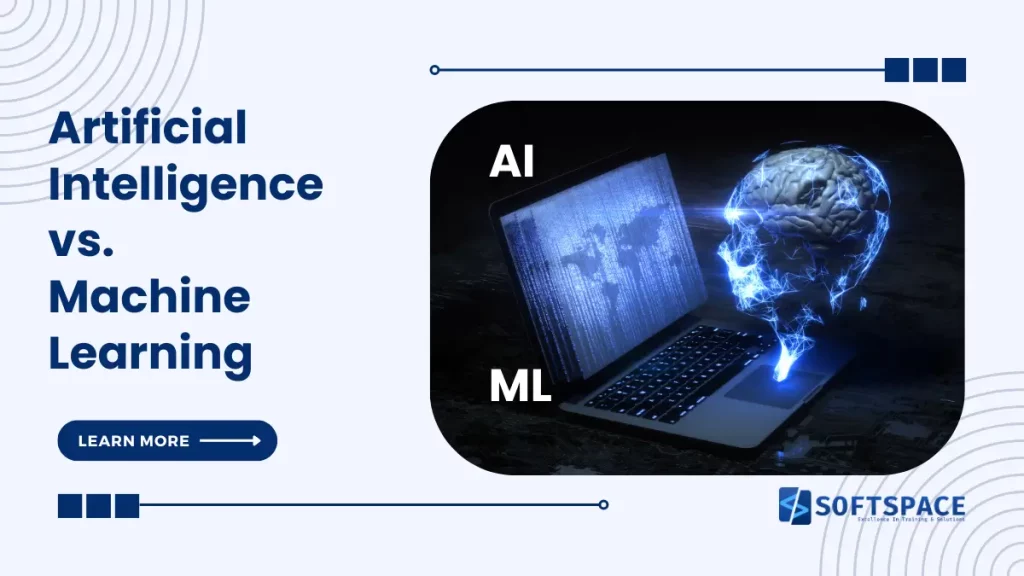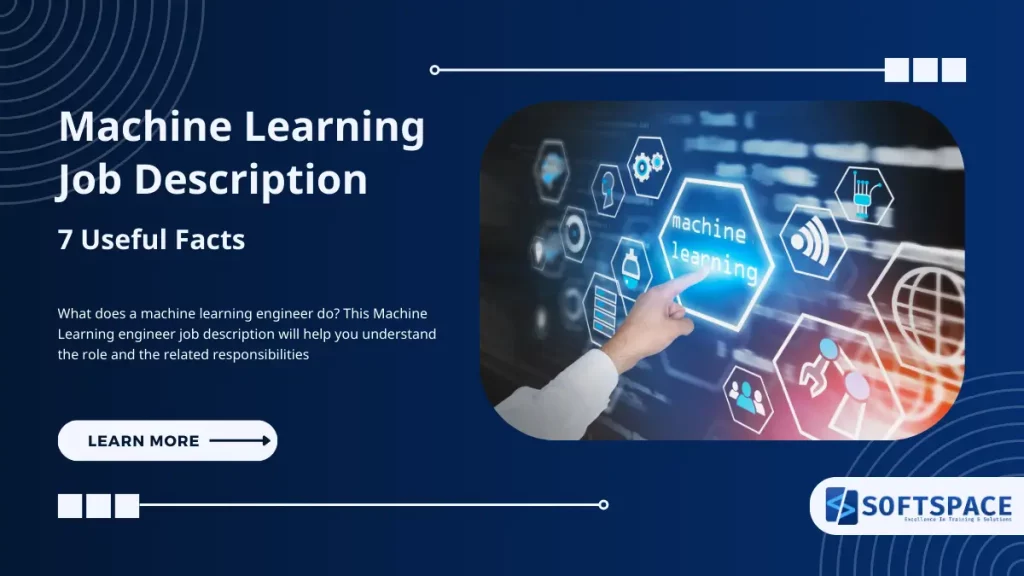Artificial Intelligence (AI) and Machine Learning (ML) are two of the most talked-about technologies today, playing a pivotal role in shaping our future. From virtual assistants and recommendation systems to autonomous vehicles and advanced healthcare diagnostics, AI and ML are transforming the way we live and work.
In this article, Artificial Intelligence vs. Machine Learning, we will help you to better understand how both are applied nowadays worldwide. You will investigate how each is altering our way of life and business and identify courses we believe will most benefit you.
7 key takeaways on Artificial Intelligence vs. Machine Learning
- AI vs. ML: A Team Effort: AI is the broad field of intelligent machines, while Machine Learning (ML) is a specific technique within AI that allows machines to learn from data. Imagine AI as the overall goal and ML as a powerful tool to achieve it.
- AI Capabilities: AI encompasses various approaches to achieve intelligence, including simple rule-based systems and complex neural networks. It focuses on replicating human intelligence in tasks like reasoning, problem-solving, and language understanding.
- ML Focuses on Learning: Machine learning excels at pattern recognition and making data-driven predictions. It allows machines to learn and improve on their own through exposure to data, without needing explicit programming for every task.
- Benefits of AI and ML: This powerful duo offers a wealth of benefits, including personalized experiences, improved decision-making through data analysis, scientific breakthroughs in various fields, and enhanced safety and security measures.
- Challenges to Consider: Job displacement due to automation and ethical considerations around bias in algorithms and data privacy are crucial issues to address as AI and ML evolve.
- The Future Holds Promise: The collaboration between AI and ML holds immense potential for personalized experiences, scientific advancements, and a better future. However, responsible development is key to ensuring these technologies benefit all of humanity.
- Understanding the Differences Matters: By grasping the distinctions between AI and ML, we can navigate the tech-driven world more effectively and make informed choices about these transformative technologies.
Table of Contents
What is Artificial Intelligence and Machine Learning?
To understand the impact of these technologies, it’s crucial to differentiate between them.
| S.No. | ARTIFICIAL INTELLIGENCE | MACHINE LEARNING |
|---|---|---|
| 1. | John McCarthy coined the term “Artificial Intelligence” in 1956 and organized the first AI conference. | Arthur Samuel, an IBM computer scientist, introduced the term “Machine Learning” in 1952. |
| 2. | AI stands for Artificial Intelligence, which refers to the capability to acquire and apply knowledge. | ML stands for Machine Learning, which involves gaining knowledge or skills through data. |
| 3. | AI is an umbrella term that includes both ML and Deep Learning (DL). | Machine Learning is a component of Artificial Intelligence. |
| 4. | The main goal of AI is to enhance the probability of success rather than focusing on accuracy. | Machine Learning prioritizes accuracy, regardless of overall success. |
| 5. | AI aims to develop systems capable of performing a wide range of complex tasks. | Machine Learning focuses on creating systems that excel at specific tasks they are trained for. |
| 6. | AI operates as a sophisticated computer program designed to perform smart tasks. | ML systems use data to learn and improve their performance over time. |
| 7. | The objective of AI is to replicate natural intelligence to tackle complex problems. | The objective of ML is to learn from data to enhance performance on specific tasks. |
| 8. | AI applications are vast and varied. | The scope of Machine Learning is more limited and specialized. |
| 9. | AI focuses on making decisions. | ML enables systems to gain insights and learn from data. |
| 10. | AI aims to create systems that can emulate human problem-solving abilities. | ML involves developing self-learning algorithms. |
| 11. | AI is a broad domain that includes ML and DL. | ML is a subset within the broader field of AI. |
| 12. |
The three main categories of AI are:
|
The three main categories of ML are:
|
| 13. | AI can handle structured, semi-structured, and unstructured data. | ML primarily deals with structured and semi-structured data. |
| 14. |
Key uses of AI include:
|
Common applications of Machine Learning include:
|
| 15. | AI is a comprehensive field focused on creating machines that can perform tasks like understanding natural language, recognizing images and sounds, making decisions, and solving complex problems. | ML is a part of AI that focuses on training algorithms with data to make predictions, decisions, and recommendations. |
| 16. | AI includes various methods for creating intelligent machines, such as rule-based systems, expert systems, and machine learning algorithms. AI systems can follow specific rules, make logical inferences, or learn from data. | ML emphasizes teaching machines to learn from data without explicit programming, using techniques like neural networks, decision trees, and clustering. |
| 17. | AI systems can utilize both structured and unstructured data, including text, images, video, and audio, to analyze and extract meaningful insights. | ML algorithms require large amounts of structured data to learn and improve. The quality and quantity of this data are crucial for the system’s accuracy and effectiveness. |
| 18. | AI covers a wide range of applications, including robotics, natural language processing, speech recognition, and autonomous vehicles. AI can address complex problems in various fields like healthcare, finance, and transportation. | ML is mainly used for pattern recognition, predictive modeling, and decision-making in areas such as marketing, fraud detection, and credit scoring. |
| 19. | AI systems can operate autonomously or with minimal human intervention, depending on the task’s complexity. They can make decisions and take actions based on provided data and rules. | ML algorithms require human involvement for setup, training, and optimization. Data scientists, engineers, and other professionals play key roles in designing and implementing ML systems. |
Artificial Intelligence (AI)
Artificial intelligence (AI) isn’t about robots taking over the world (yet!). It’s about machines that can learn and act intelligently. Imagine computers that can solve problems, make decisions, and even understand human language. AI encompasses a wide range of technologies, from self-driving cars to medical diagnosis tools.
In healthcare, for example, AI is being used to analyse patient data, assist in diagnostics, and even automate the coding of medical conditions using ICD 10 codes. This automation helps ensure accuracy in clinical documentation, streamlines medical billing, and reduces administrative burdens on healthcare providers.
The goal? To create machines that can think and act like humans, automating tasks and making our lives easier.
To build a career in AI, you need to have a practical understanding of the core concepts as well as their practical applications. All this knowledge you can gain from Artificial Intelligence Courses designed especially for the industry requirements.
Machine learning (ML)
It is a powerful tool within AI, but it takes a different approach. Instead of explicitly programming a computer for every task, ML focuses on teaching machines to learn for themselves. Imagine a student constantly studying data, improving its abilities as it encounters more information. That’s ML in action!
ML algorithms analyze vast amounts of data, identifying patterns and relationships. Over time, they become better at making predictions and decisions without needing specific instructions. This is what powers recommendation systems on Netflix or spam filters in your email – all thanks to machines that keep learning and getting smarter.
Artificial Intelligence vs. Machine Learning
Artificial intelligence (AI) and machine learning (ML) are like the chef and sous chef in the kitchen of intelligent machines. AI sets the ambitious goal of human-like intelligence, tackling complex problems and mimicking our decision-making. It’s the visionary leader, with a wide range of applications and the ability to handle different types of data, like recipes (structured data) or handwritten notes (unstructured data).
Machine learning, on the other hand, is the skilled learner. It devours past data (cookbooks) to identify patterns and improve its performance on specific tasks. Imagine asking your smart assistant about your commute.
The AI system, acting as the chef, aims to answer your question just like you might by researching traffic. But behind the scenes, the ML sous chef is busy analyzing real-time traffic data to predict congestion. This allows the AI to deliver the desired information, showcasing how AI sets the goal and ML provides the learning tool that empowers intelligent machines.
Artificial Intelligence Features
- Enables machines to emulate human intelligence for problem-solving
- Aims to create intelligent systems capable of executing complex tasks
- Develops systems that can tackle intricate problems like humans
- Has a broad range of applications
- Employs technologies to replicate human decision-making processes
- Handles all types of data: structured, semi-structured, and unstructured
- Utilizes logic and decision trees to learn, reason, and self-correct
Machine Learning Features
- Allows machines to learn autonomously from historical data
- Aims to build machines that improve accuracy by learning from data
- Trains machines to perform specific tasks and achieve precise outcomes
- Has a narrower range of applications compared to AI
- Uses self-learning algorithms to create predictive models
- Works with structured and semi-structured data
- Relies on statistical models for learning and self-corrects with new data
Real-world example of AI
- Smartphones and Virtual Assistants: The virtual assistants on your smartphone like Siri or Google Assistant use AI for speech recognition and natural language processing. They can understand your voice commands, answer your questions, and even complete tasks like setting reminders or making calls.
- Social Media Feeds: The content you see on social media platforms like Facebook or Instagram is personalized through AI algorithms. These algorithms consider your past likes, shares, and interactions to curate a feed that’s most likely to keep you engaged.
- Self-Driving Cars: While not yet commonplace, self-driving car technology relies heavily on AI. These cars use a combination of sensors, cameras, and AI software to navigate roads, perceive their surroundings, and make decisions in real time.
- Spam Filtering: Ever wondered why most spam messages never reach your inbox? AI-powered spam filters analyze incoming emails, identifying patterns and keywords associated with spam content. This helps keep your inbox clean and protects you from phishing attempts.
- Recommendation Systems: The “because you bought this” suggestions on online shopping platforms or the movie recommendations on streaming services like Netflix are all powered by AI. These recommendation systems analyze your past purchases or viewing habits to suggest similar items you might be interested in.
- Medical Diagnosis: AI is increasingly used in the medical field to assist doctors with diagnosis and treatment plans. AI algorithms can analyze medical images like X-rays or MRIs to identify abnormalities and even suggest potential diagnoses.
Benefits of Artificial Intelligence (AI): Transforming Our World
Artificial intelligence (AI) is rapidly transforming our world, bringing a wave of innovation and advancements across various sectors. Here’s a glimpse into some of the key benefits AI offers:
- Enhanced Efficiency and Productivity: AI automates repetitive tasks, freeing up human time and resources for more complex endeavours. Imagine AI-powered robots handling assembly lines in factories or chatbots managing customer service inquiries, allowing humans to focus on creative problem-solving and strategic planning.
- Data-Driven Decision Making: AI excels at analyzing vast amounts of data, and identifying patterns and trends that humans might miss. Businesses can leverage AI to make informed decisions, optimize operations, and predict market fluctuations. In healthcare, AI can analyze patient data to personalize treatment plans and improve overall health outcomes.
- Personalized Experiences: AI tailors experiences to individual preferences. Recommendation systems on streaming services or online shopping platforms use AI to suggest products or content you’re likely to enjoy. Similarly, AI-powered chatbots can personalize customer interactions, providing targeted support and enhancing user satisfaction.
- Scientific Breakthroughs and Innovation: AI is a powerful tool for scientific research and discovery. It can analyze complex data sets in fields like genomics or astronomy, leading to groundbreaking discoveries and advancements in various scientific disciplines. AI can also assist in developing new materials, designing life-saving drugs, and accelerating the pace of scientific progress.
- Improved Safety and Security: AI plays a crucial role in safety measures. Self-driving cars use AI for navigation and collision avoidance, while facial recognition technology can enhance security systems. AI can also be used to detect fraud and cyberattacks, protecting individuals and businesses from financial losses.
- 24/7 Availability and Scalability: AI-powered systems can operate continuously without breaks, offering round-the-clock services and support. Additionally, AI systems can be easily scaled up or down to meet changing demands, making them adaptable and efficient solutions for various needs.
Real-world examples of machine learning (ML) in action
- Streaming Service Recommendations: Have you ever noticed how Netflix or Spotify curate suggestions that seem to perfectly align with your taste? This is thanks to ML algorithms. These systems analyze your viewing habits, listening history, and even ratings to identify patterns and predict what shows, movies, or songs you’d enjoy next. The more you use the platform, the more data the ML algorithm gathers, continuously refining its recommendations for a personalized experience.
- Smart Spam Filtering: Ever wondered why most spam emails never reach your inbox? ML algorithms power spam filters, constantly learning and evolving to identify spam content.
These systems analyze incoming emails, looking for patterns in language, sender information, and even attachment types. With every email you mark as spam or not spam, the ML algorithm refines its understanding, improving its ability to filter out unwanted messages and keep your inbox clean.
- Fraud Detection in Online Transactions: Protecting your financial information is crucial. Many online payment platforms utilize ML algorithms to detect fraudulent activity. These systems analyze transaction patterns, looking for suspicious behaviours like unusual purchase locations, large amounts spent in short periods, or inconsistencies in the billing information.
By constantly learning from past fraudulent attempts, the ML algorithm becomes adept at identifying and preventing fraudulent transactions, safeguarding your financial security.
- Image Recognition Technology: Facial recognition on your smartphone or filtering photos based on content (e.g., searching for pictures with beaches) are powered by ML. These algorithms are trained on massive datasets of images and labels, allowing them to identify objects, faces, and even scenes within a photograph. The more images the system is exposed to, the better it becomes at recognizing patterns and accurately classifying visual content.
- Voice Assistants Getting Smarter: Virtual assistants like Siri or Google Assistant are constantly learning and improving, thanks to ML. These systems analyze your voice commands and past interactions to understand your preferences and respond more effectively. The more you use a virtual assistant, the better it tailors its responses to your specific needs and communication style.
Benefits of Machine Learning (ML): Powering Intelligent Systems
Machine learning (ML) has become a transformative force across various industries, offering a multitude of benefits that enhance our lives and work. Here’s a breakdown of some key advantages:
- Improved Decision Making: ML excels at analyzing vast amounts of data, uncovering hidden patterns and trends that might escape human analysis. This empowers businesses to make data-driven decisions, optimize operations, and predict future outcomes. Imagine a retail store using ML to analyze customer purchase history and predict future demand, ensuring they have the right inventory in stock.
- Enhanced Automation and Efficiency: ML automates repetitive tasks, freeing up human time and resources for more strategic endeavours. Repetitive tasks like data entry, image recognition, or fraud detection can be handled by ML algorithms, allowing humans to focus on creative problem-solving and higher-level thinking.
- Personalized Experiences: ML algorithms personalize experiences across various platforms. Whether it’s suggesting movies you might enjoy on a streaming service or recommending products you’d likely purchase online, ML tailors recommendations based on your past behaviour and preferences. This personalization fosters user engagement and satisfaction.
- Innovation and Faster Development Cycles: ML can accelerate research and development processes. In drug discovery, for example, ML can analyze vast datasets of molecular structures to identify potential drug candidates, significantly reducing the time it takes to develop new medications. Similarly, in material science, ML can help design new materials with specific properties, leading to quicker innovation cycles.
- Predictive Maintenance and Reduced Costs: ML can predict equipment failures or breakdowns before they occur. By analyzing sensor data from machinery, ML algorithms can identify early warning signs of potential issues, allowing for preventive maintenance. This proactive approach reduces downtime, saves on repair costs, and ensures smooth operations.
- Improved Accuracy and Reliability: As ML algorithms are exposed to more data, they continuously learn and improve their accuracy. This translates to more reliable systems, whether it’s spam filters that become adept at identifying unwanted emails or facial recognition software that gets better at accurately matching faces.
Artificial Intelligence vs. Machine Learning: Core Differences
Picture a bullseye. The whole target represents Artificial Intelligence (AI), the vast world of intelligent machines. Now, draw a smaller circle right in the centre – that’s Machine Learning (ML). AI encompasses everything from self-driving cars to chatbots – any system that mimics human intelligence.
Machine learning is a specific technique within AI where computers learn from data, constantly improving without needing explicit programming. So, AI is the broad goal of intelligent machines, and machine learning is a powerful tool to achieve that goal.
AI vs. ML: Decoding the Similarities and Differences
Imagine you want to build a super-smart machine. Artificial Intelligence (AI) is your ultimate goal – a machine that can reason, solve problems, and understand language like a human.
Machine Learning (ML) is a powerful tool in your AI toolbox. It allows your machine to learn from data, identify patterns, and make decisions on its own, without needing constant hand-holding. Here’s how they differ:
- Focus: AI is all about replicating human intelligence, while ML focuses on the learning aspect.
- Capability: AI has a wider skill set, including simple rule-based systems and complex neural networks. ML excels at tasks that involve finding patterns and making data-driven predictions.
- Techniques: Think of AI as a toolbox with various tools. ML is a specific set of techniques within that toolbox, like statistical analysis and algorithms.
The Benefits & Future of AI and ML
Businesses and consumers alike can profit from a variety of AI and machine learning technologies. Businesses might anticipate lower expenses and more operational efficiency, while customers can anticipate more individualized services.
It should come as no surprise that the global AI market is predicted to grow rapidly in the upcoming years. The artificial intelligence market is expected to grow from $136.6 billion in 2022 to a staggering $1.8 trillion in 2030, according to Grand View Research (GVR).
Businesses that use AI and machine learning in the real world often profit from the following:
- The capacity to swiftly evaluate vast volumes of data and generate practical insights.
- Reduced labour expenses translate into a higher return on investment (ROI) for related services.
- Enhanced client happiness and experiences that may be customized to fit the demands of certain customers.
The Other Side of the Coin
The future of AI and ML is bright, but not without its challenges. As these technologies become more sophisticated, we need to consider:
- Job displacement: As AI automates tasks, some jobs might disappear. We need to prepare for a changing workforce and equip people with the skills needed to thrive in the AI age.
- Ethical considerations: AI algorithms can perpetuate biases present in the data they’re trained on. Ensuring fairness and addressing privacy concerns around how data is collected and used in ML systems is crucial.
AI and ML are powerful tools, but like any tool, they require responsible use. By acknowledging these challenges and working towards solutions, we can ensure AI and ML benefit all of humanity.
Conclusion
Artificial Intelligence (AI) and Machine Learning (ML) aren’t rivals, but rather teammates in the field of technological advancement. While AI represents the broad objective of intelligent machines, ML serves as a powerful tool within that vision. Understanding the distinctions between them empowers us to navigate this tech-driven world.
ML focuses on enabling machines to learn and improve independently, while AI encompasses a wider range of techniques to achieve intelligence. Imagine AI as the architect and ML as the skilled builder – both crucial for constructing the marvels of intelligent machines.
This collaboration unlocks a treasure chest of possibilities. Personalized experiences, enhanced decision-making, and scientific breakthroughs are just a glimpse of what the future holds. However, challenges like job displacement and ethical considerations require us to tread carefully.
By acknowledging these hurdles and fostering responsible development, we can ensure AI and ML become a force for good, shaping a brighter future for all.

13+ Yrs Experienced Career Counsellor & Skill Development Trainer | Educator | Digital & Content Strategist. Helping freshers and graduates make sound career choices through practical consultation. Guest faculty and Digital Marketing trainer working on building a skill development brand in Softspace Solutions. A passionate writer in core technical topics related to career growth.





